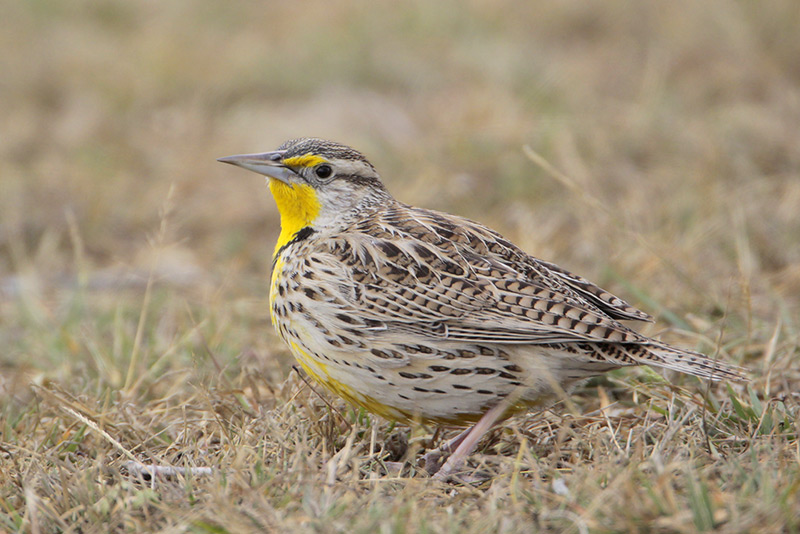
Western Meadowlark – North Dakota State Bird
The birds of North Dakota include 414 species of grassland birds, sandpipers, and beautiful ducks! In North Dakota, we can listen to the lovely songs of Western Meadowlarks, watch flocks of bugling Sandhill Cranes, and look for the elusive Yellow Rail.
North Dakota is a wild and beautiful place for birds! How many bird species have you seen in North Dakota? We bet you’ve seen a lot but how many could you identify?
This list of the top 25 most common backyard and wild birds in North Dakota will help!
On this page
Most Common Birds of North Dakota (Top 25)
According to eBird data from 2021 to 2023, the following list shows the 25 most common birds of North Dakota.
To help with identification, we also included information about their behavior and key field marks (remember that the species on the bottom of the list are common birds too!).
Black-capped Chickadee (Most common wild bird in North Dakota)
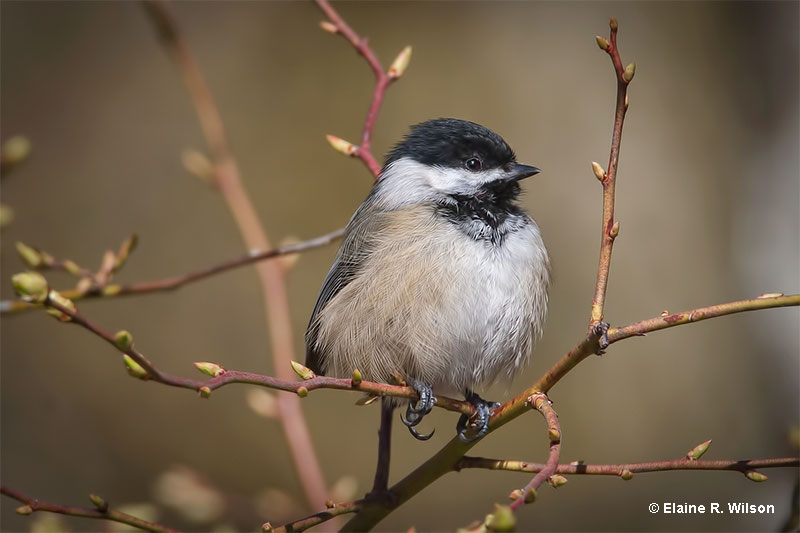
Scientific name: Poecile atricapilla
Length: 5.25 inches
Weight: .39 ounces
Wingspan: 8 inches
Song: “see bee, see bee”
Black-capped Chickadees are small grayish birds with a black cap, black throat, and white cheeks. Both sexes look alike and have a white face, white edging to the feathers in their wings, and some buff on their underparts.
These cute little birds feed on caterpillars, insects, spiders, seeds, and fruit. They are regular visitors to backyard feeders but also forage on bark, twigs, and in foliage.
When foraging, they often hang upside down from twigs and usually occur in small flocks.
This species makes a small, soft nest out of moss and deer hair. It builds its nest in tree cavities and can also use nest boxes.
Black-capped Chickadees live in a variety of wooded habitats and can also occur in gardens. They are year-round residents in parts of Alaska, Canada, and the northern USA south to Oregon, northern New Mexico, northern Ohio, and the Appalachian Mountains to North Carolina.
Key Identifications:
- Small, cute, grayish birds with a black cap, white face, and a black throat.
- Forages for insects, spiders, seeds, and fruit in wooded habitats. Also visits feeders to enjoy peanuts and other seeds. They even enjoy peanut butter!
- Nests in tree cavities and nest boxes.
- This little bird is quite vocal and often says its name, “chick-a-deedeedeedeedee”. They also make other chattering calls and sing a whistled song, “see bee, see bee”.
The Black-capped Chickadee is a small, acrobatic bird with a black cap, white face, and a black throat. It is also a state bird of Massachusetts. They usually forage in flocks with other chickadees and other small birds, and often visit feeders. This species hides dozens of seeds and other bits of food for the winter, and recalls where each of these food items are hidden.
American Robin

Scientific name: Turdus migratorius
Length: 10 inches
Weight: 2.7 ounces
Wingspan: 17 inches
Song: “cheery, cheery, cheery, cheery, cheer, cheer”
The American Robin is a familiar and common thrush that is dark gray above and brick red below. It also has an orange-yellow bill, a blackish head with white markings around the eyes and on the throat, and a white belly.
Both sexes of this thrush species are similar, but males are darker above and more reddish on the underparts. Young American Robins have more white marks on their faces and spotting on orange underparts.
In flight, this common thrush in North Dakota also shows white corners in its outer tail feathers.
American Robins forage on the ground for worms, insects, snails, and other small creatures. In winter, these common birds flock together and perch in trees and bushes to eat berries and fruit.
The American Robin makes a cup nest in trees and lives in parks, woodlands, towns, and many other habitats. They reside in Alaska, most of Canada, the USA and in Mexico.
Key Identifications:
- Fair-sized songbird that is dark gray above, and brick red and white below.
- Forages for worms and bugs on lawns and other open grassy areas, also flocks together to feed on fruiting trees in the winter.
- Makes a cup nest in trees.
- The American Robin is quite vocal and makes a loud, sharp, “yenk!” call and quieter “check,check,check” calls. It also has a lovely cheerful song of caroled phrases, “cheery, cheery, cheery, cheery, cheer, cheer”.
With an estimated population of 370 million, the American Robin is considered to be the most numerous landbird in North America.
House Sparrow
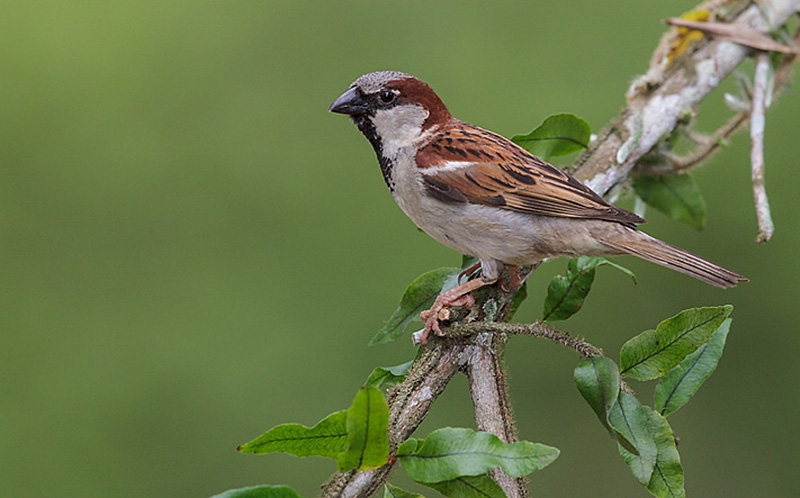
House Sparrow (Passer domesticus) perched on a branch in the Atlantic rainforest of southeast Brazil.
Scientific name: Passer domesticus
Length: 6.25 inches
Weight: .98 ounces
Wingspan: 9.5 inches
Song: “see,chirrup,see,chirrup,see,chirrup”
House Sparrows are small, plump gray and brown birds with conical, finch-like beaks. Males have a gray and rufous head with pale cheeks, and black near their eyes and on their throat.
The rest of their underparts are gray and they have brown, streaked backs with rufous highlights. They also have a white mark in the shoulder of each wing and a grayish rump and tail.
Females are plainer brown and buff, have paler beaks, and buff eyebrows.
House Sparrows feed on seeds, grain, and insects. They are regular visitors to bird feeders and often dominate other smaller species. They also forage on the ground in farmlands, parks, urban areas, and other open situations.
The House Sparrow nests in cavities. When searching for suitable nesting sites, they can kill and remove the eggs and young of smaller species like Eastern Bluebirds.
House Sparrows usually live near people and occur in most of North America, including North Dakota.
Key Identifications:
- Brown and gray sparrow with a bold pattern on its head.
- Feeds on seeds, grain, and insects at feeders and on the ground in urban areas and farmlands.
- Nests in tree cavities, including nest boxes.
- This species is vocal and often makes short chirping calls. Its song is a friendly series of chirping sounds, “see,chirrup,see,chirrup,see,chirrup”.
In many places, the House Sparrow is the common urban sparrow. It occurs in pairs and small groups that forage on sidewalks, in parking lots, farm fields, and other familiar places. This species is one of the very few birds that has evolved to live with people and digest the same grains that we eat.
Mourning Dove
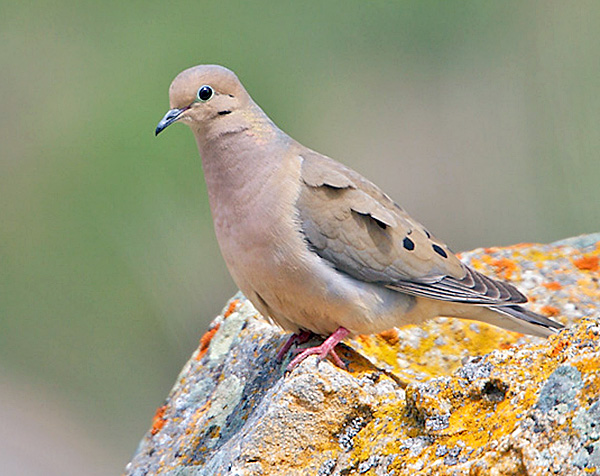
Photograph © Greg Lavaty.
Scientific name: Zenaida macroura
Length: 12 inches
Weight: 4.2 ounces
Wingspan: 18 inches
Song: “hooOOA, hoo, hoo, hoo”
Mourning Doves are medium-sized, grayish-brown doves with long tails. They have small black spots on their wings and a small head with a slender, dark beak.
Males and females also have narrow gray eyerings, a black mark on the face, and pale iridescent gold on the sides of their necks. They look alike except for males having more gray on the head and neck, and more iridescence.
This dove has fairly long wings and swift, direct flight. When flying, it shows black and white in its tail.
The Mourning Dove occurs in woodlands, gardens, on farms, and in urban areas. This common feeder visitor eats seeds and grains. It also forages in open situations, picking food from the ground.
This pleasant dove species can visit a feeder on its own or forage in small flocks. It builds an unkempt stick nest in bushes and trees and is very common throughout the USA, southern Canada, and Mexico.
Key Identifications:
- Plain brown and gray dove with a long, pointed tail.
- Feeds on seeds at feeders and on the ground in open areas.
- Makes a small, messy nest of sticks in trees.
- Sings a sad and owl-like “hooOOA, hoo, hoo, hoo”.
The Mourning Dove is the common garden dove in most of its range. It often visits feeders and its cooing song is commonly mistake for an owl. This species has a short lifespan with many adults only living for a couple of years or less.
White-breasted Nuthatch
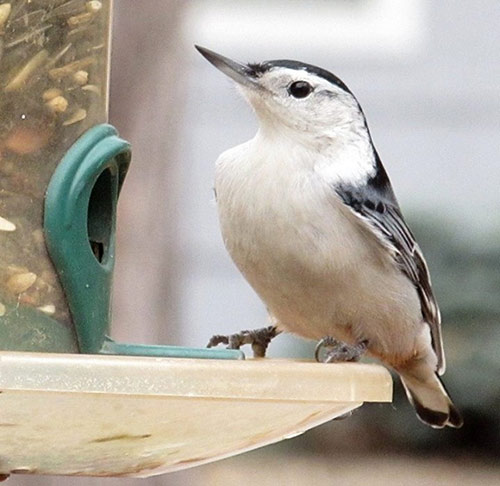
Scientific name: Sitta carolinensis
Length: 5.75 inches
Weight: .74 ounces
Wingspan: 11 inches
Song: “wehn wehn wehn wehn wehn wehn wehn wehn”
The White-breasted Nuthatch is a sparrow-sized bird with a longish, sharp, slightly upturned beak and a short black and white tail. It also has long wings, is mostly blue-gray above, and white and gray below with some chestnut on its belly and undertail.
Both sexes look similar and have a white face, but males have a black cap and nape. Females have gray on their head and nape.
This small bird forages for insects, nuts, and seeds by creeping along branches and going down trunks, head-first. It uses its beak to pick food items from bark and also visits feeders.
The White-breasted Nuthatch makes a cup nest out of grass and soft bark inside a tree cavity or nest box.
White-breasted Nuthatches live in various wooded habitats in parts of southern Canada, most of the USA, and mountains in Mexico. They are frequent visitors to gardens near woodlands.
Key Identifications:
- Sparrow-sized, short-tailed songbird that is blue-gray above, mostly white below, and has a longish, slightly upturned beak.
- Creeps on branches and down tree trunks for insects, nuts, and seeds. Also visits feeders.
- Uses grass and soft bark to make a cup nest in a tree cavity or nest box.
- Quite vocal and makes nasal calls “yank yank”, and sings a nasal, laughter-like song, “wehn wehn wehn wehn wehn wehn wehn wehn”.
White-breasted Nuthatches are small blue-gray and white birds with slightly upturned beaks. They creep down trees in many wooded areas and are regular visitors to feeders. This species prefers to forage in flocks with chickadees and titmouse species because they are good at finding food and quick to make alarm calls when they see a predator.
Canada Goose
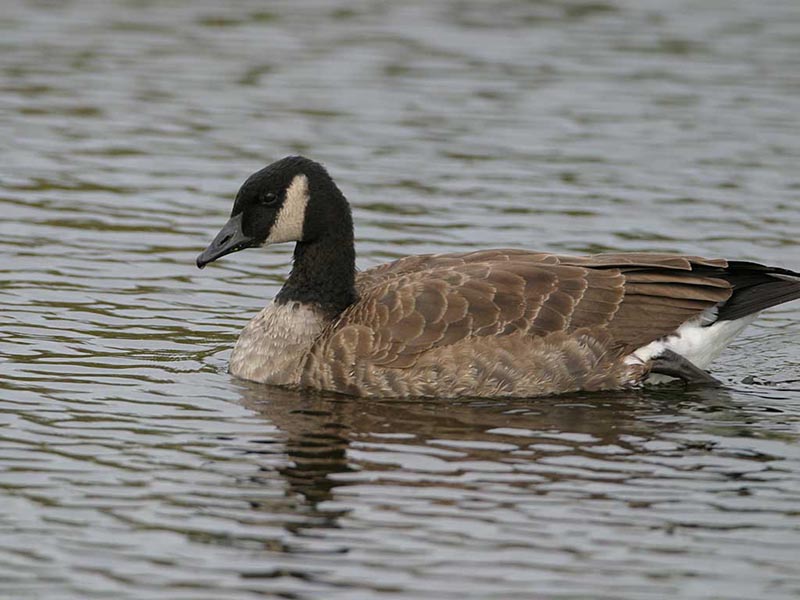
Scientific name: Branta canadensis
Length: 35 – 45.2 inches
Weight: 5.29 – 19.8 pounds
Wingspan: 50 – 67 inches
Song: “uurrRUNK! uurrRUNK!”
The Canada Goose is a large, grayish-brown bird with a long black neck, and black head with a white throat and cheeks. Males and females look alike and have pale barring, a white belly and undertail, and a short black and white tail.
They have strong direct flight and make deep flaps with long, broad wings.
Canada Geese feed on grass, sedges, and other vegetation, grain, and berries. They forage by walking along and grazing, or picking food from the ground and bushes. This species also feeds by dipping its head below the surface of shallow water.
This large goose uses grass and other plants to make a large, shallow cup nest on a small mound or other elevated spot next to water.
The Canada Goose prefers open grassy areas and farm fields near water where it can feed and see predators before they get too close. They live in Alaska, most of Canada, and most of the USA, being one of the most common birds of North Dakota.
Key Identifications:
- Big, gray-brown goose with a long black neck, and black and white head.
- Grazes vegetation and forages for berries in wide open, grassy habitats near water like golf courses, parks, and airports.
- Makes a shallow, open cup nest on an elevated spot next to water.
- Vocal and often makes honking calls, “uurrRUNK! uurrRUNK!”.
Canada Geese are a large, common goose species with long black necks, and a black and white head. These big birds are a common sight on golf courses and other places that combine open lawns and water. When the Canada Goose and other birds migrate in “V” formation, they expend less energy than flying on their own.
Mallard
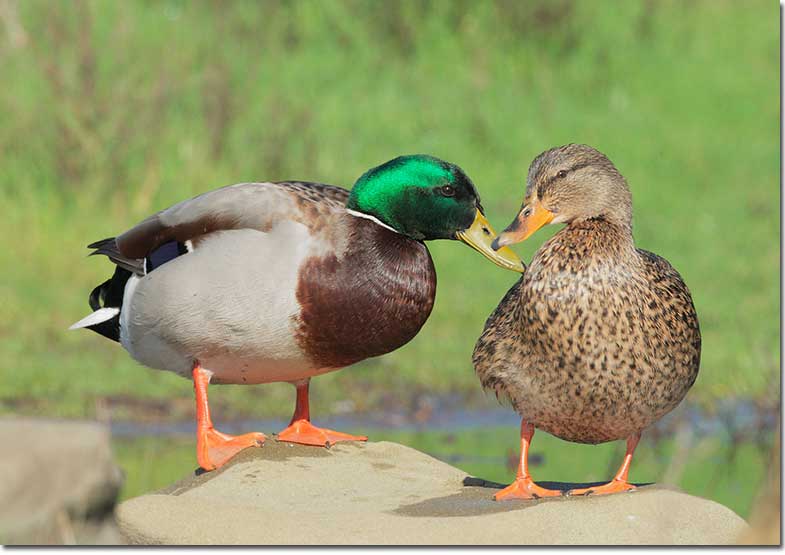
Mallard pair (Male and female)
Scientific name: Anas platyrhynchos
Length: 23 inches
Weight: 2.4 pounds
Wingspan: 35 inches
Song: “quack, quack”
The Mallard is a fairly large, familiar duck. The male has a metallic green head, yellow bill, narrow white ring around the neck, and chestnut breast. The rest of the bird is pale gray with pale brown, and black on its back and around his tail.
Female Mallards are mottled brown and buff with a dark crown and line through the eyes, and have a dark gray and orange beak.
In flight, both sexes show a green-blue wing patch bordered with white.
Mallards eat a variety of items including insect larvae, snails, other small aquatic creatures, acorns, seeds, and grain. They forage by filtering and picking up food items in and near shallow water, and in farm fields.
This North Dakota duck species makes a shallow nest with sticks and lined with down feathers. It builds its nest on the ground, hidden in grass or under a bush.
The Mallard lives in ponds, marshes, and many wetland habitats in Canada, USA, and Eurasia.
Key Identifications:
- Feeds on insect larvae, grain, seeds, and other items picked up with its bill in and near shallow water.
- Makes a shallow stick nest hidden in grass or under a bush.
- The female Mallard makes the classic “quack, quack” duck sound. Males make similar but softer sounds and a whistling call.
The Mallard is a fairly large and familiar duck with a dark green head (the male), or is buff and brown with a dark gray and orange beak (the female). Thus duck species often lives near people and occurs on lakes, ponds, and other wetlands. No matter how different they look, most small domestic duck species are descended from wild Mallards.
American Crow
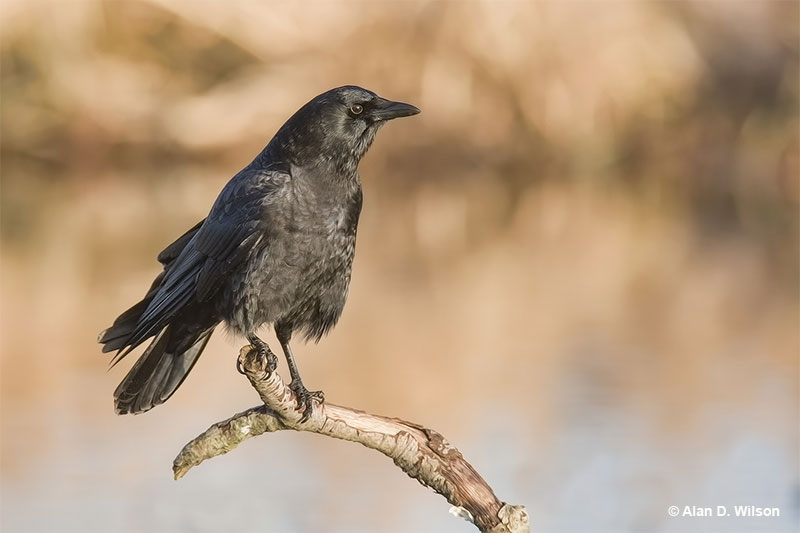
Scientific name: Corvus brachyrhynchos
Length: 17.5 inches
Weight: 1 pound
Wingspan: 39 inches
Song: “Caw! Caw!”
The American Crow is a big, all black bird with a strong, stout bill. In certain lighting, it can have metallic purple and blue iridescence.
Both sexes look the same and have some feathering on their beaks, long, broad wings, and a broad tail.
American Crows have direct flight with strong, steady wing beats. Crows are very social and intelligent birds that are usually seen in flocks. They forage together on the ground or in trees and eat just about anything they can find.
Some of their more regular foods include carrion, fruit, nuts, seeds, insects, and small animals. Like most jays and crow species, they also eat the eggs and nestlings of other bird species.
This species builds bulky stick nests high in trees and lives in most habitats except for high mountains and arid zones.
The American Crow occurs in southern Alaska and much of Canada and the USA.
Key Identifications:
- Big, all black bird with long, broad wing and a broad tail.
- Forages for carrion, fruit, seeds, insects, and small animals.
- Builds a bulky stick nest high in a tree.
- American Crows are very vocal birds. They can make several calls but their most common one is, “Caw! Caw! Caw!”.
The American Crow is a common, large black bird that frequently calls, “Caw! Caw! Caw!”. It usually occurs in flocks and lives in all sorts of places, even urban zones. These birds are very smart and have funerals or wakes! When a crow dies, other crows mark the occasion by gathering together and loudly calling.
Red-winged Blackbird
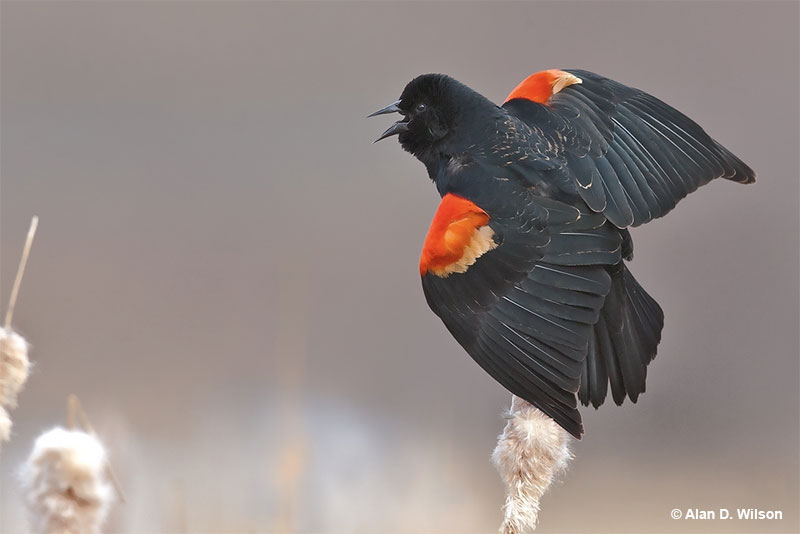
Scientific name: Agelaius phoeniceus
Length: 8.75 inches
Weight: 1.8 ounces
Wingspan: 13 inches
Song: “kan-keree!”
The Red-winged Blackbird is a medium-sized blackbird species with a sharp, all black bill. Males also have a scarlet patch with a pale yellow border on the shoulder of each wing.
Female Red-winged Blackbirds are dark, heavily streaked, brownish-gray birds with an orange-buff eyebrow and throat. She can also have a little bit of dingy red on her shoulder.
Red-winged Blackbirds often flock together and can form very large groups in the winter. They feed on seeds, grain, and insects found on lawns, in marshes, farm fields, and other open habitats.
This species builds a cup nest made of leaves and dead stems in a bush or other low vegetation in a marsh, park, or brushy field.
Red-winged Blackbirds are very common birds that live in all sorts of open habitats. We see them in parks, farming areas, and marshes in much of Canada, the USA, Mexico, and parts of the Central America.
Key Identifications:
- Males are medium-sized blackbirds with a bright red patch on their wings. Females are heavily streaked, have a sharp black beak, and buff on the head.
- Feeds on seeds, grain, and insects on the ground in many open habitats.
- Builds a cup nest in a bush or other low vegetation.
- Red-winged Blackbirds often call. Males sing a loud, “kan-keree!” and both sexes also make “check!” calls and a high-pitched whistle-like sound.
The Red-winged Blackbird is a common, social species easily seen in marshes and open habitats. In the winter, it can form huge flocks that feed in farm fields. This species can make a daily commute of 50 miles to and from roosting and feeding sites.
American Goldfinch
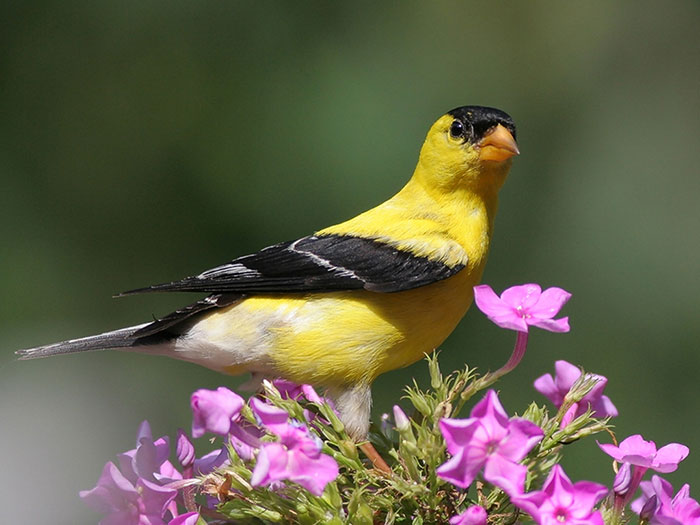
Scientific name: Carduelis tristis
Length: 5 inches
Weight: .46 ounces
Wingspan: 9 inches
Song: “swit sweet, sipsipsipchichisweetsweet”
The American Goldfinch is a small, sparrow-sized finch with a black and white, slightly forked tail, pale rump, and white undertail. In summer, males are bright lemon yellow with a small black cap, pale beak, and have some white markings on long black wings.
Females and wintering birds have two pale wings bars and have plain gray, buff, and yellowish plumage. This species often occurs in small flocks and has bounding flight.
American Goldfinches feed on seeds. They forage by picking them from grass, thistle, other low plants, Alders, and other trees. Goldfinches are also frequent visitors to bird feeders.
The American Goldfinch uses plant matter and other soft materials to build a small, tightly woven cup nest high in a shrub or a low tree.
American Goldfinches are summer residents in southern Canada, California, and the northern half of the USA, and winter in most of the USA and parts of Mexico.
Key Identifications:
- Small, bright yellow finch with a black cap, wings and tail (summer male), female and winter males are plain brown, buff, and yellowish birds with two pale wing bars.
- Feeds on seeds in low plants, trees, and at feeders.
- Makes a tightly woven cup nest high in a shrub or low tree.
- Often gives a “per chickory” call in flight and sings a short, trilled song, “swit sweet, sipsipsipchichisweetsweet”.
American Goldfinches are small, common backyard birds that frequent around weedy and brushy fields, second growth, and parks. Outside of the breeding season, they occur in small flocks and often visit feeders. Brown-headed Cowbirds that hatch in American Goldfinch nests die after a few days because they can’t survive on a diet of seeds.
Downy Woodpecker
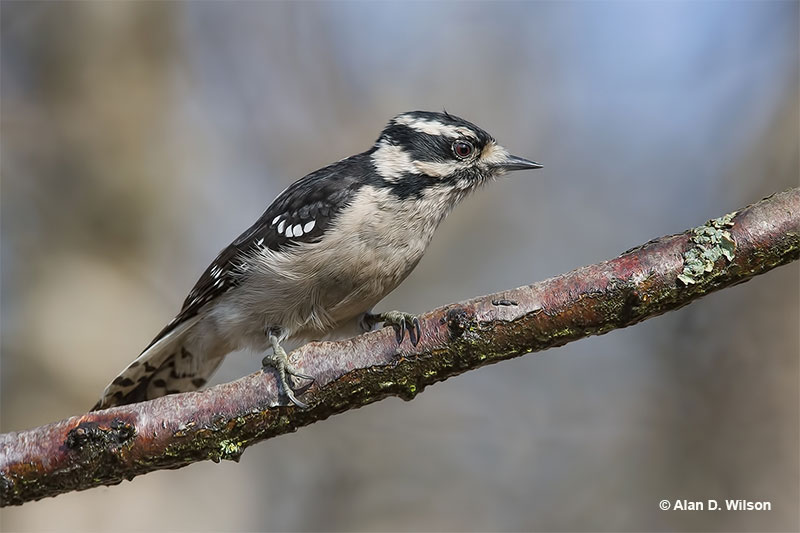
Scientific name: Dryobates pubescens
Length: 6.75 inches
Weight: .95 ounces
Wingspan: 12 inches
Song: “Pik! Ch,ch,ch,ch,ch,ch,ch!”
The Downy Woodpecker is a small black and white woodpecker with a short, black beak. They are patterned black and white above and have white backs and white underparts. Both sexes look alike except that males have a small, bright red patch on the top back part of their head.
Young birds look like adults but have a reddish patch on the top of their head. Downy Woodpeckers also have a few small black marks in their white outer tail feathers, and a small white tuft at the base of their beak.
This woodpecker eats insects, other small creatures, seeds, and small fruits. It pecks into live and dead wood and often forages on smaller branches and twigs. These friendly little woodpeckers are also common feeder birds.
They nest in tree cavities and live in gardens and a wide variety of woodlands. We see Downy Woodpeckers in much of Canada and the USA but not in arid habitats.
Key Identifications:
- Smallest woodpecker in North America. Mostly black and white with a short, black beak.
- Forages on trees, in bushes, and at feeders for insects, seeds, and suet.
- Nests in tree cavities.
- The Downy Woodpecker makes sharp “pik!” calls and also has a trilled call, “Ch,ch,ch,ch,ch,ch,ch!“.
Downy Woodpeckers are the smallest woodpecker species in North America and usually occur in pairs. They can also forage with other small birds and often visit feeders. This species takes advantage of its size to peck into the stems of weeds and other plants too small for larger woodpeckers to perch on.
Dark-eyed Junco
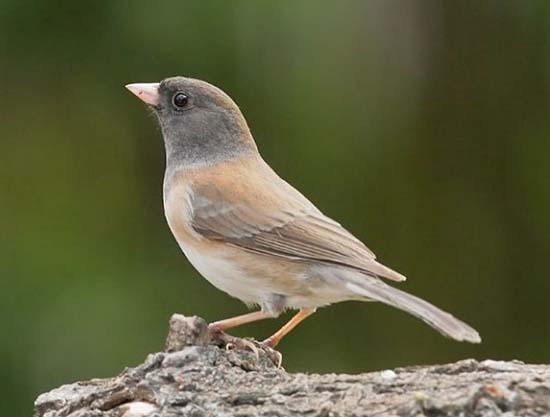
Scientific name: Junco hyemalis
Length: 6.25 inches
Weight: .67 ounces
Wingspan: 9.25 inches
Song: “sipsipsipsipsipsipsip”
Dark-eyed Juncos are sparrow-like birds with pale conical bills and dark eyes. This small bird has variable plumage with most being slate gray or gray and brown with white on their bellies, and white under their tails.
Other plumages include birds with dark masks and faint white wing bars, juncos with pale gray hoods and pinkish sides, and birds with blackish hoods and chestnut sides.
In flight, all Dark-eyed Juncos show extensive white in their longish tails.
This species feeds on seeds, insects, and some fruit and grain. Juncos forage on the ground in wooded areas, parks, and other habitats. They also feed on fallen seeds beneath feeders.
They build cup nests on the ground under fallen logs, in roots, and other hidden spots. After breeding, juncos form flocks that forage together in similar wooded and semi-open habitats.
Dark-eyed Juncos are common birds in Canada, the USA, and parts of Mexico.
Key Identifications:
- Sparrow-like gray and brown bird with dark eyes, a pale beak, and white in the tail.
- Forages for seeds and insects on the ground, can feed on seeds at and beneath feeders.
- Builds a cup-shaped nest on the ground in tree roots, under logs, and other hidden places.
- This species often makes a sharp, high-pitched chip note, “pik!”. On breeding grounds, males sing a short, plain trill, “sipsipsipsipsipsipsip”.
Dark-eyed Juncos are sparrow-like, gray and brown birds with much white in the tail. Common wintering birds in many areas, they forage for seeds on the ground in wooded and park-like habitats. In many places, this common species is also known the “Snowbird” on account of only occurring in the winter months and having white on the belly and tail.
Common Grackle
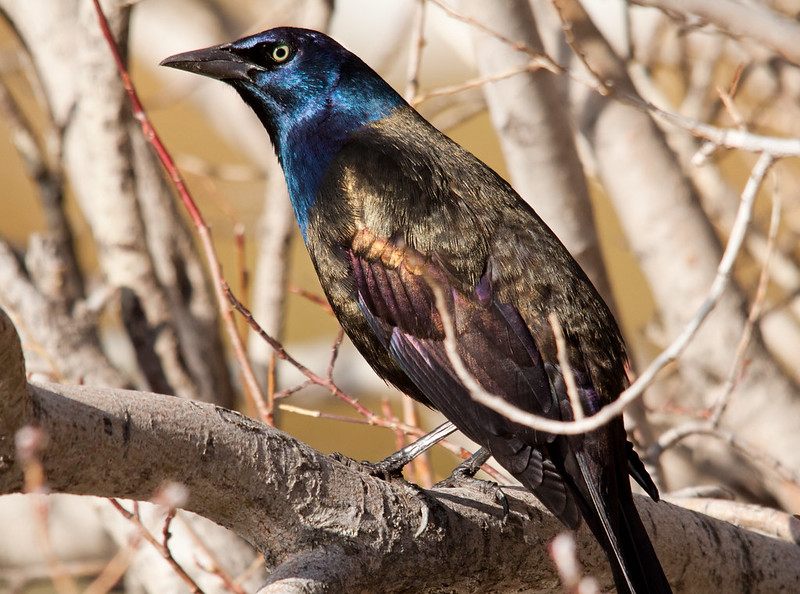
© Shawn McCready
Scientific name: Quiscalus quiscula
Length: 12.5 inches
Weight: 4 ounces
Wingspan: 17 inches
Song: “Sherink!”
The Common Grackle is a jay-sized, glossy black bird with pale eyes and a long, wedge-shaped tail. Depending on lighting, this bird shows metallic purple, blue, green, and bronze highlights.
Males and females look very similar but females have shorter tails and less iridescence. Both sexes also have stout, black beaks, and strong, black legs and feet.
In flight, Common Grackles move up and down as they move through the air. They usually flock together and often forage in farm fields, on lawns, and in other open habitats. These omnivores feed on a variety of items including insects, seeds, grain, small animals, garbage, and the eggs and nestlings of other birds.
Common Grackles build bulky stick nests, usually in conifers in woodlands, parks, near water, and urban areas.
This species can form big flocks in the winter and lives in a variety of semi-open and open habitats in eastern Canada and the eastern USA.
Key Identifications:
- Fairly large, black bird with glossy purple, greenish, bronze, or dark blue highlights. It also has pale eyes and a long, wedge-shaped tail.
- Forages for insects, seeds, and other food on the ground in a variety of open habitats.
- Constructs a bulky cup nest in a conifer.
- Common Grackles are vocal birds. They frequently give raspy, metallic calls, “Sherink!”, and “kek” calls.
The Common Grackle is a common, glossy black bird with pale eyes. It usually occurs in flocks in open and park-like habitats. This species occasionally nests in odd places, including occupied nests of Great Blue Herons and Ospreys!
House Finch
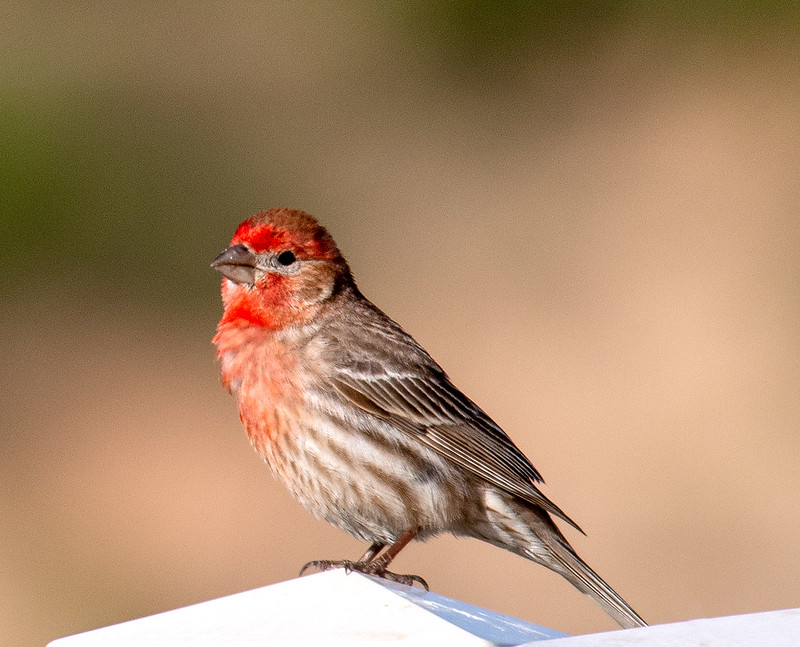
Photograph © John Hansen
Scientific name: Haemorhous mexicanus
Length: 6 inches
Weight: .88 ounces
Wingspan: 10 inches
Song: “chip,chip,chiprididip,ZREEYachip”
House Finches are sparrow-sized birds with dark, rounded beaks and fairly long wings. Males are orange-red or rose-red on their head, throat and breast, and have some red on their rump. They also have brownish streaks on their back, flanks, and white belly.
Like males, female House Finches have two white wing bars on long, gray-brown wings. However, they lack red and are mostly streaked, dull brown-gray birds.
House Finches feed on seeds, buds, fruit, and flowers. They often visit feeders in North Dakota but also forage on the ground, and in bushes and trees.
We see these pretty birds in deserts and arid zones, and in parks, farmland, urban areas, and other semi-open habitats.
The House Finch makes a soft cup nest built on a tree, building ledge or other spot with some overhanging cover. They often occur in small groups and live in southern Canada, most of the USA, Mexico, and Hawaii.
Key Identifications:
- Reddish or plain gray-brown, streaked, sparrow-like bird.
- Eats seeds, flowers, buds, and fruit. Can visit feeders but also forages on the ground and in bushes and trees.
- Makes a soft cup nest in trees, on building ledges, and other places.
- The House Finch often makes a soft, “fidip” call. Males also sing a warbling song from prominent, high perches. It sounds like, “chip,chip,chiprididip,ZREEYachip”.
House Finches are sparrow-like, reddish or brownish, streaked birds. They live in arid zones as well as in parks and urban areas. All of the millions of House Finches that live east of the Rocky Mountains are descendants of birds released on Long Island in 1939.
Blue Jay
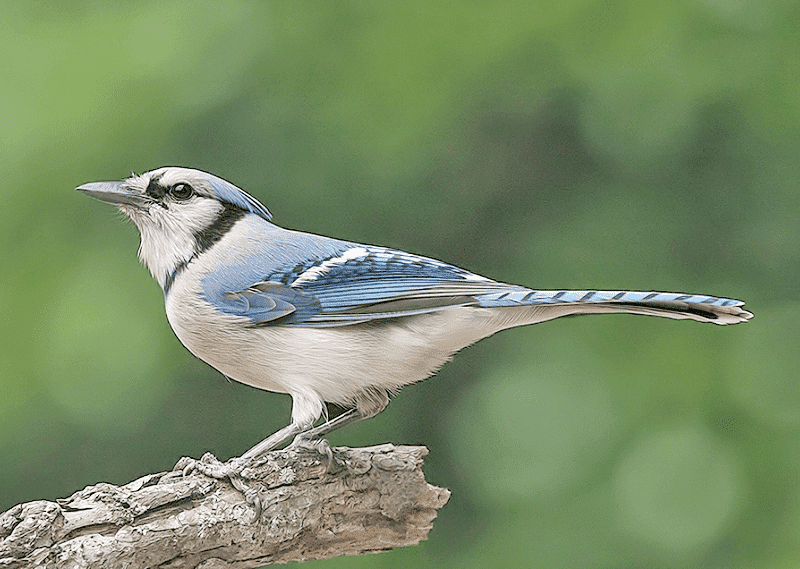
Photograph © Alan Wilson.
Scientific name: Cyanocitta cristata
Length: 11 inches
Weight: 3 ounces
Wingspan: 16 inches
Song: “Nyeah! Nyeah! Nyeah!”
The Blue Jay is a fairly large, crested bird with a straight black bill. Both sexes look alike and are blue above and gray and white below. They also have some small black lines on their faces and a narrow black necklace that goes up to the side of their face and crest.
Blue Jays also have some white markings and black barring in their wings and on their tail. Young birds look like adults but are duller blue.
They make messy cup nests at various heights in a variety of trees.
These social and intelligent birds feed on acorns, nuts, insects, and other small creatures. Like other members of the jay and crow family, they eat the eggs and nestlings of other birds.
The Blue Jay is a common bird of woodlands, forest, and towns east of the Rocky Mountains in the USA and central and southern Canada.
Key Identifications:
- Crested, fairly large bird with bright blue above and gray below.
- Feeds in trees and at feeders. Eats acorns, nuts, insects and many other food items.
- Makes a messy cup nest of sticks in a tree.
- Very vocal. In flight, Blue Jays often call as they swoop through the trees. They make a variety of sounds and mimic some other birds. Common calls include a nasal and complaining “Nyeah! Nyeah! Nyeah!” and various whistled calls.
The Blue Jay is a common, intelligent, and noisy bird. They make their presence known with their loud calls and can visit feeders. Ironically, when communicating with each other at close quarters, this species makes much softer and quieter calls. It’s almost as if they are talking with each other!
Hairy Woodpecker
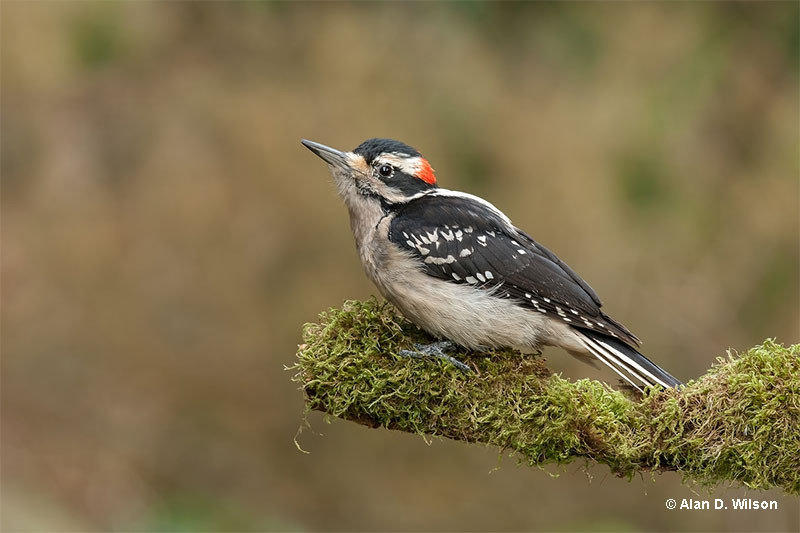
© Alan D. Wilson
Scientific name: Dryobates villosus
Length: 9.25 inches
Weight: 2.3 ounces
Wingspan: 15 inches
Song: “Qquechichichichichichicchichic!”
Hairy Woodpeckers are medium-sized, black and white woodpeckers with long, straight beaks. They have a white patch on their back and a black and white tail with unmarked, white outer tail feathers.
Both sexes look very similar but males have a small, bright red spot on the back of their head. Young birds have a dull red patch on top of their heads.
This woodpecker species feeds on insects, other small creatures, and a variety of seeds and fruit. They forage by pecking into bark and picking berries and other fruit from branches. In areas with big, mature trees, Hairy Woodpeckers are also regular visitors to bird feeders.
The Hairy Woodpecker nests in tree cavities. This species lives in parks and woodlands with mature trees in Alaska, much of Canada, and in most of the USA, including North Dakota.
They are absent from southern Florida and arid parts of the American Southwest.
Key Identifications:
- Medium-sized, black and white woodpecker with a long straight beak and unmarked, white outer tail feathers.
- Picks insects and fruit from bark of big trees, also eats seeds at feeders.
- Nests in tree cavities.
- Often calls and gives a sharp and explosive, “Peek!” and a longer rattle, “Qquechichichichichichicchichic!”.
Hairy Woodpeckers are medium-sized, black and white woodpeckers with long, straight beaks. They need woodlands and parks with big trees and dominate the smaller Downy Woodpecker at feeders. This species gets its name from fine, hair-like feathers on its back.
Ring-billed Gull
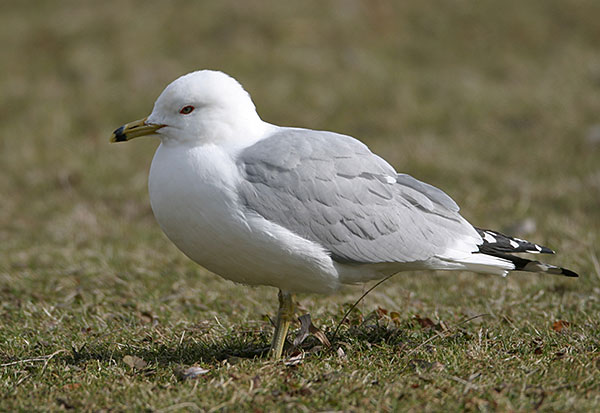
Scientific name: Larus delawarensis
Length: 17.5 inches
Weight: 1.1 pound
Wingspan: 48 inches
Song: “KLEE..KLEEE..kleeya,kleeya,kleeya”
The Ring-billed Gull is a medium-sized pale gray and white gull with a black ring around its yellowish beak. Males and females look the same and have yellowish legs and feet, pale eyes, and black wing tips with a few white spots.
These gulls have direct, fairly quick flight with leisurely wing beats. Young birds have pink and black bills, a white tail with a black tip, and mottled black and gray wings.
Ring-billed Gulls are scavengers and opportunists that feed on carrion, fish, worms, small animals, grain, and other food items. They usually occur in flocks that roam lakes, rivers, urban areas, and other habitats in search of feeding opportunities.
The Ring-billed Gull breeds in colonies, often on islands, and makes a shallow stick nest on the ground.
This gull species occurs not only in North Dakota, but also in many parts of Canada and the USA south to Central America.
Key Identifications:
- Medium-sized pale gray and white gull with a black ring on its bill and yellow legs and feet. Juveniles have pink and black beaks.
- Forages for fish, carrion, and many other food items in wetlands and open habitats.
- Nests on the ground, in colonies.
- Ring-billed Gulls often call. In flight, they often make a high-pitched “kleea” sound. On the ground, displaying birds make a loud, laughing, “KLEE..KLEEE..kleeya,kleeya,kleeya”.
Ring-billed Gulls are pale gray and white, medium-sized gulls with a black ring around their beaks and yellow legs and feet. They are well adapted to living with people and occur around lakes, rivers, and other wetlands, parking lots, garbage dumps, and other places. This gull species is a bold bird that can snatch bits of food from unguarded picnic tables.
Chipping Sparrow
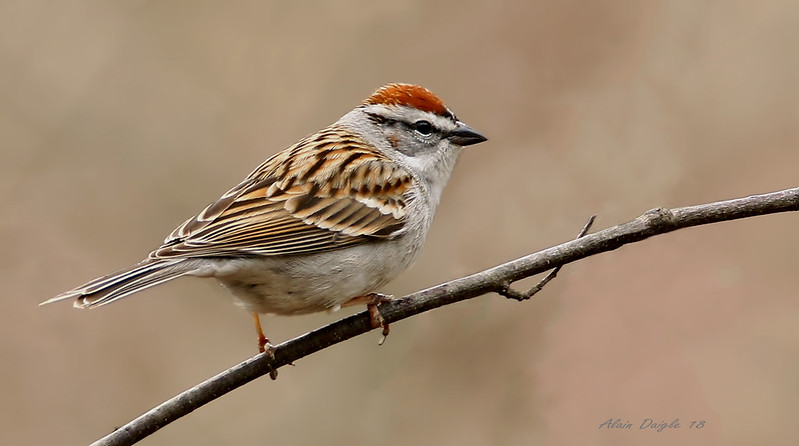
© Alain Daigle
Scientific name: Spizella passerina
Length: 5.5 inches
Weight: .42 ounces
Wingspan: 8.5 inches
Song: “titititititititititititti”
The Chipping Sparrow is a small, brown and gray sparrow with a longish, slightly forked tail and a conical bill. In summer, it has a rufous cap, white eyebrow, and dark line through each eye.
Males and females look the same and have small white crescents above and below the eyes, a pale brown back with dark streaks, gray rump and underparts, and pale brown wings with two pale wing bars.
In fall and winter, Chipping Sparrows are duller, have brown and buff heads, a gray rump, and a dark line through their eyes.
This species forages on the ground for insects and small seeds in open, grassy areas near conifers.
Chipping Sparrows use grass, hair, and other materials to make a cup nest low in a bush or small tree.
These sparrows live in parks, open woodlands, and on golf courses in much of Canada, most of the USA, and parts of Mexico.
Key Identifications:
- Small, slender sparrow with a rufous cap and white eyebrow in summer and a brown and buff head, gray rump, and dark line through their eyes in the winter.
- Forages for insects and seeds on the ground in grassy habitats with pines.
- Uses grass and animal hair to make an open cup nest low in a bush or small tree.
- Makes short chip notes and has a mechanical sounding, trilled song, “titititititititititititti”.
The Chipping Sparrow is a small and slender sparrow with a rufous cap and pale eyebrow. They are common birds of golf course and other similar, semi-open habitats and flock together during the winter. Chipping Sparrows eat more than 70 times their own weight in seeds, every winter!
Killdeer
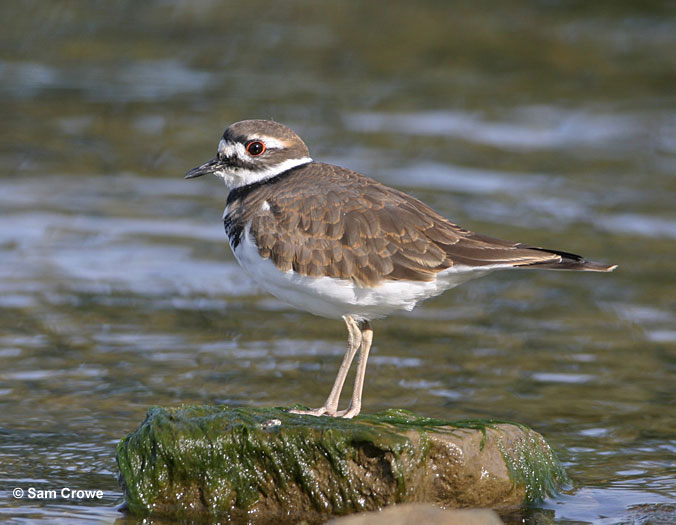
Scientific name: Charadrius vociferus
Length: 10.5 inches
Weight: 3.3 ounces
Wingspan: 24 inches
Song: “tideer, tideer, tideer, tideer”
The Killdeer is a fair-sized, slender plover that is dark brown above and white below. They have two black bands on their breast, a patterned, black, white, and dark brown head, and a longish, orange tail.
Both sexes look alike and also have a slender, black bill, narrow, red-orange eyerings, and long, pale legs. In flight, we can see a white stripe in each of their long, dark wings, and a black tip on their long, wedge-shaped, orange tail.
Killdeers often fly high overhead in fast, direct flight, but we usually see them foraging on the ground. They pick insects, other small creatures, and seeds from the edges of wetlands and other, open grassy areas.
This species lays its camouflaged eggs on the ground, in gravel and open fields. When people and pets approach too close, they give loud calls and pretend to have a broken wing.
The Killdeer lives in large parts of Canada, the USA, Mexico and North Dakota.
Key Identifications:
- Fair-sized plover with two black breast bands and a wedge-shaped orange tail with a black tip.
- Picks seeds and small creatures from open ground.
- Lays camouflaged eggs on the ground, in gravel and open fields.
- Very vocal and sounds like it says its name, “tideer, tideer, tideer, tideer”.
The Killdeer is the most common and familiar shorebird in much of its range and occurs in many open habitats. It is the only plover in North America with two black breast bands and has a longish, orange tail with a black tip. To scare cows near their nests, Killdeers fluff themselves to look bigger, raise their tail over their head, and run at the large animal.
Red-breasted Nuthatch
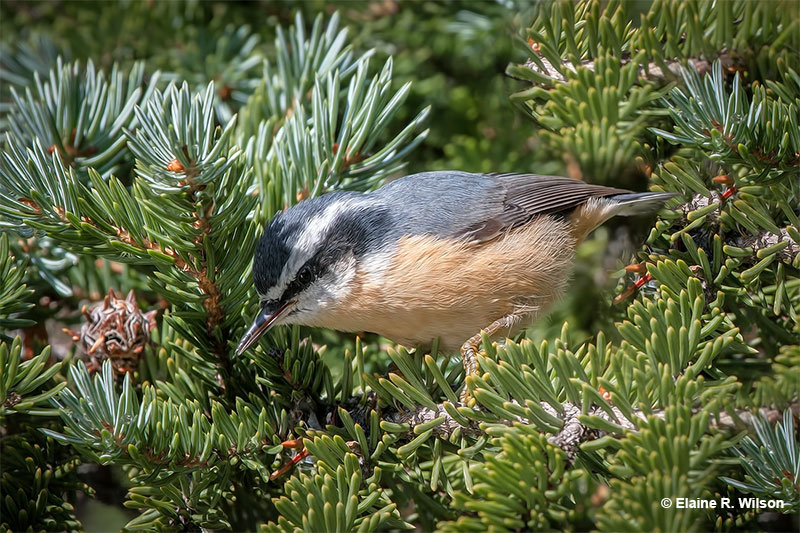
© Elaine R. Wilson
Scientific name: Sitta canadensis
Length: 4.5 inches
Weight: .35 ounces
Wingspan: 8.5 inches
Song: “yeank, yeank, yeank”
The Red-breasted Nuthatch is a small, warbler-sized bird with a dark gray, straight or slightly upturned beak, gray upperparts, and reddish-orange underparts. It also has a black cap, a white face with a narrow black mask, and black and white in its short tail.
Males and females are similar, except that females are paler and have a gray cap.
Red-breasted Nuthatches eat insects during the summer and conifer seeds in the winter. These small, animated birds forage by creeping down coniferous tree trunks and on branches. They use their bills to probe bark and pick out insects and seeds.
This species excavates a tree cavity and makes an open nest of bark and other vegetation.
The Red-breasted Nuthatch lives in coniferous and mixed forests in southern Alaska, Canada, and the western and northern USA. They also breed in the Appalachians and can be seen in most of the USA in winter.
Key Identifications:
- Small, short-tailed bird with a narrow white eyebrow, black mask, gray upperparts, and reddish-orange underparts.
- Creeps along tree trunks and branches to forage for insects and conifer seeds.
- Nests in tree cavities.
- The distinctive nasal call of the Red-breasted Nuthatch, “yeank, yeank, yeank”, is a good way to find this bird.
The Red-breasted Nuthatch is a small, short-tailed bird with black and white on its head, gray upperparts, and reddish-orange underparts. It usually occurs alone and lives in coniferous woods and trees. To protect its nest, this species puts sticky pine resin around the border of its nesting hole.
Western Meadowlark
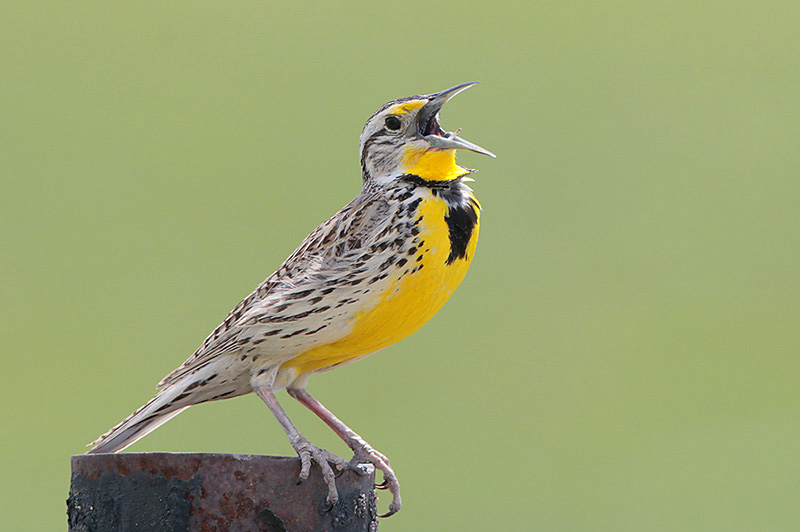
Scientific name: Sturnella neglecta
Length: 9.5 inches
Weight: 3.4 ounces
Wingspan: 14.5 inches
Song: “trip tree tur ripuhdip”
The Western Meadowlark is a chunky pale brown and yellow bird with a long, straight beak. Males and females look alike and have a large black “V”-shaped mark on their bright yellow breast. The rest of their underparts are white with some dark marks on their flanks.
They also have a narrow white stripe down the middle of their dark crown, a long yellow and white eyebrow, and a pale face with a dark line going back from their eyes.
This bird shows white in the tail, especially in flight, and also has a little bit of yellow on the lower part of the face.
Western Meadowlarks forage on the ground in open habitats for insects and seeds.
This species uses grass and other bits of vegetation to make a hidden nest on the ground.
The Western Meadowlark lives in a variety of open habitats in parts of Canada, the central and western United States, and Mexico. They are common birds of North Dakota.
Key Identifications:
- Robin-sized, pale brown and yellow rotund bird with a black “V” mark on its breast.
- Forages for insects and seeds on the ground in open habitats.
- Makes a hidden, dome-like nest out of grass and soft vegetation, on the ground.
- This birds has a rattle call, often in flight, and sings a pleasant, melodious whistled song, “trip tree tur ripuhdip”.
Western Meadowlark is the state bird of North Dakota. Pairs are conspicuous in wide open habitats of central and western North America. On account of its beautiful song and appearance, this conspicuous bird was chosen to be the official bird for six different states.
Northern Flicker
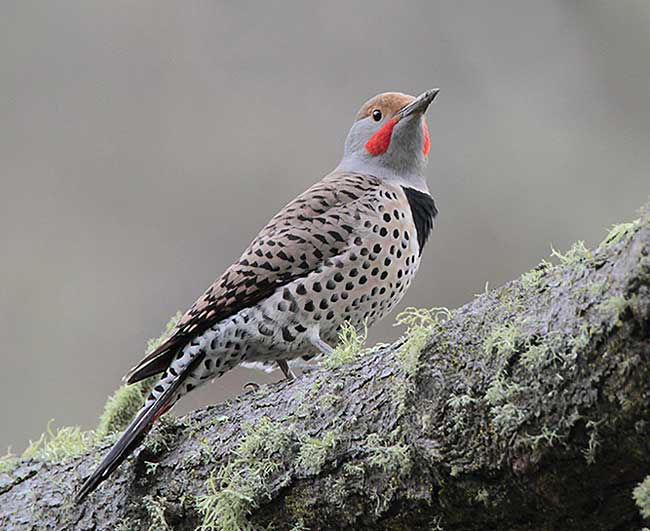
Scientific name: Colaptes auratus
Length: 12.5 inches
Weight: 4.6 ounces
Wingspan: 20 inches
Song: “kick,kick,kik,kik,kik.kik.kik.kik.kik.kik.kik.kik!”
Northern Flickers are fairly large, tan and gray woodpeckers with barring on their backs. They have a black mark on their breast, black spotting below, and a dark, stout beak.
Males in the east have a tawny throat and face with a black moustache and small red spot on the back of their heads. Males in the west have mostly gray heads with a red moustache.
Female Northern Flickers look like males but lack the moustache mark.
In bounding flight, they have white rumps and flash color on their underwings. This is bright yellow in eastern birds and reddish in flickers west of the Rocky Mountains.
This woodpecker eats many ants and other insects that it catches on the ground. It forages by flying to the ground, locating anthills, and lapping them up with its long tongue.
Northern Flickers nest in tree cavities and live in wooded and open habitats in Canada, the USA, and Mexico.
Key Identifications:
- Tan and gray woodpecker with black barring above, black marks below, and a bright, white rump.
- Forages for ants and other insects on the ground.
- Nests in tree cavities.
- A vocal woodpecker, the Northern Flicker often gives loud, “flicka,flicka,flicka” calls, and another loud, single note that sounds like, “Keer!” They also have a long, laughing vocalization of repeated notes, “kick,kick,kik,kik,kik.kik.kik.kik.kik.kik.kik.kik!”.
Northern Flickers are fairly big, tan woodpeckers with gray highlights, a white rump, and black markings. They mostly forage for ants on the ground in open and wooded areas. The red-shafted Northern Flickers in the west used to be considered a separate species from the yellow-shafted flickers of the east. At present, they are considered to be one species because they frequently hybridize with each other.
Ring-necked Pheasant
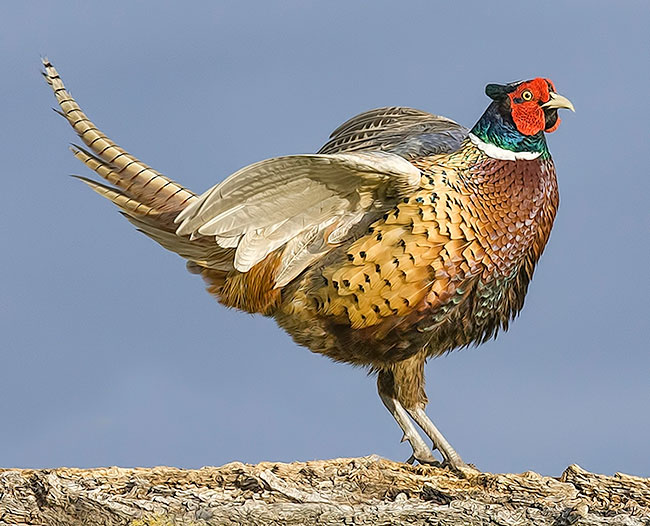
Scientific name: Phasianus colchicus
Length: 21 inches
Weight: 2.5 pounds
Wingspan: 31 inches
Song: “hruh kook”
The Ring-necked Pheasant is a big, chestnut brown and gray ground bird with dark barring on its long, pointed tail.
Male Ring-necked Pheasants are rich chestnut and golden-brown, and have a dark green head with a short crest. They have a red face and a white collar. This species also has gray on its rump and wings, white spotting on its back, and black spotting on its sides.
Female Ring-necked Pheasants are buff-brown birds with mottled upperparts and a pale belly.
Ring-necked Pheasants forage by picking up grain, seeds, fruit, grass, and insects from the ground.
This species nests on the ground in spots with tall grass and other dense vegetation. The female makes a shallow nest out of grass and other bits of vegetation.
The Ring-necked Pheasant breeds in grasslands and weedy fields in parts of western, central, and eastern Canada, and mostly in the north-central and western USA. It is native to northern Eurasia.
Key Identifications:
- Big, mottled brown or chestnut bird with a white collar and dark green head, and a long, pointed tail.
- Forages on the ground for grain, insects, and seeds.
- Nests on the ground in dense grass and scrubby vegetation.
- The male makes a loud, hoarse call, “hruh kook”.
The Ring-necked Pheasant is a big ground bird with a long, pointed tail, dark green head, and narrow white collar. This species is fairly common in grassland habitats. Ring-necked Pheasants are Asian birds that were introduced to North America in the 1880s.
Song Sparrow
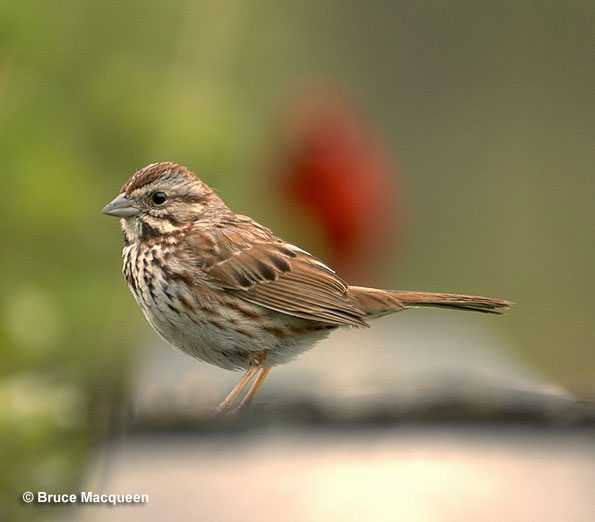
Scientific name: Melospiza melodia
Length: 6.25 inches
Weight: .7 ounces
Wingspan: 8.25 inches
Song: “seet serate sitsziziziziziziziz seet”
The Song Sparrow is a small, gray and brown, streaked songbird with a thick dark mark on each side of its white throat. Males and females look the same and have white underparts with a dark brown mark on their breast, and dark brown streaks on their breast and sides.
Most Song Sparrows also have two narrow wing bars and show a rounded tail when fluttering between bushes.
This species feeds on insects, seeds, and small fruits. Pairs forage by picking up food items on and near the ground. They are also frequent visitors to bird feeders.
Song Sparrows use grass, stems, hair, and other materials to make a cup nest placed on or near the ground. They nest in dense vegetation, shrubbery, or low trees, often near water.
This species uses a wide variety of brushy habitats in open and wooded situations in southern Alaska, most of Canada, and all of the USA.
Key Identifications:
- Small brown, streaked sparrow with a dark mark on its breast.
- Forages on and near the ground for seeds and insects in brushy habitats.
- Builds a cup nest on or near the ground in a shrub or low tree.
- Makes high-pitched “tink”, chirping calls, and has a cheerful song with a trill, “seet serate sitsziziziziziziziz seet”.
Song Sparrows are reddish-brown songbirds with dark brown streaks and a dark brown breast patch on white underparts. They usually occur in pairs and are often heard and seen in brushy areas and large gardens. There are several subspecies with distinct plumages including a large, dark one that lives on the Aleutian Islands.
European Starling
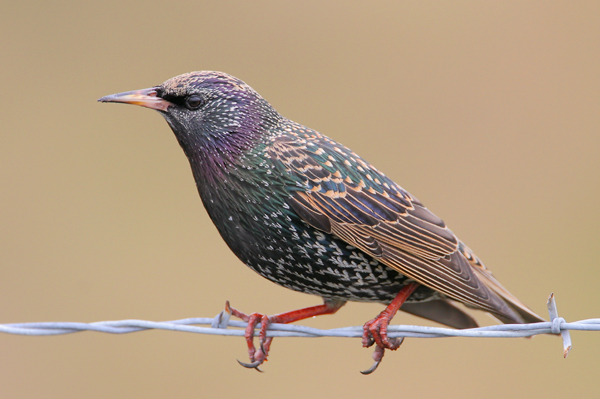
Photograph © Greg Lavaty.
Scientific name: Sturnus vulgaris
Length: 8.5 inches
Weight: 2.9 ounces
Wingspan: 16 inches
Song: “tiktiktitZHREEree..tiktiktik..ZHREE”
European Starlings are plump, short-tailed birds with long sharp beaks and longish, pointed wings. In summer, they have yellow beaks, glossy black plumage with purple and green highlights, and some small white spots.
Males and females are similar but males have less spotting and glossier plumage. In winter, they have black beaks, white spots, and more reddish colors in their wings.
Young starlings are shaped like adults but are grayish birds with a dark beak and a pale throat.
This species feeds on a variety of insects, fruit, and seeds. They can dominate bird feeders and are common species in urban areas, parks, farmlands, and other open habitats.
This European Starling builds a soft cup nest in a tree cavity, nest box, or suitable cavity in other structures.
European Starlings flock with each other and blackbird species, especially during the winter. They live across a large part of Canada and the USA.
Key Identifications:
- Rotund, short-tailed bird with a long, sharp beak, and pointed wings. Glossy black with some spotting in the summer and blackish with heavy white spotting and streaking in the winter.
- Feeds on seeds, fruit, and insects. Visits feeders and forages on the ground in flocks.
- Builds a soft cup nest in nest boxes and other cavities.
- The European Starling makes a wide variety of mechanical and whistled sounds. They also mimic other birds and sounds in their environment. They sing long, jumbled mechanical-sounding songs, “tiktiktitZHREEree..tiktiktik..ZHREE”.
European Starlings are rounded, blackish birds with long, sharp beaks and short tails. They live in towns, cities, parks, on farms, and in other open habitats. This species forms large flocks called, “murmurations” that move in coordinated patterns.
Birds of North Dakota – Frequently Asked Questions
How many bird species are native to North Dakota (ND)?
In total, 414 bird species are native to North Dakota. This is the number of bird species that have been seen in the state.
What is the most common bird in ND?
The most common bird in North Dakota is the Black-capped Chickadee. According to breeding bird surveys and sightings on the eBird platform, this small bird is seen more than any other bird species in the state.
What is the largest bird in North Dakota?
The largest bird in ND is the American White Pelican. This huge wetland species is 62 inches long, weighs 16.4 pounds, and has a 9-foot wingspan!
What is the smallest bird in ND?
The smallest bird in North Dakota is the Calliope Hummingbird. This rare visitor is only 3.25 inches long and weighs 0.1 ounces.
What are the tiny brown birds in North Dakota?
The tiny brown birds in ND could be any number of sparrow species, the House Wren, or female longspurs.

